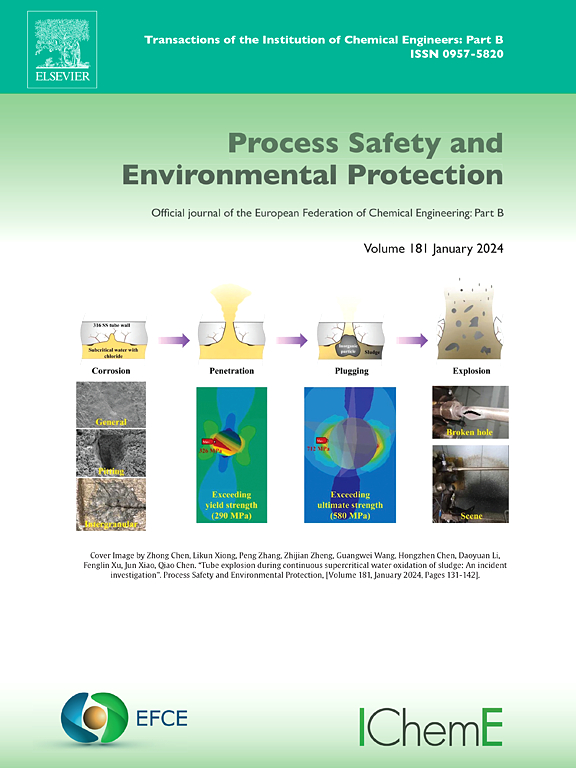微波强化赤泥铁/铝回收:碳热还原和碱活化在矿物转化中的机理作用
IF 6.9
2区 环境科学与生态学
Q1 ENGINEERING, CHEMICAL
引用次数: 0
摘要
红泥是一种全球普遍存在的工业副产品,由于其碱性和重金属含量,造成了严重的环境风险,而传统的处理方法仍然是能源密集型和低效的。本研究开发了一种微波辅助策略,结合碳热还原和碱性活化来实现同步铁/铝回收。微波通过内部加热和选择性加热促进快速矿物相变,而碳酸钠添加剂优先将含铝相转化为酸溶铝酸盐(NaAlO2/NaAlSiO4),而不影响Fe2O3的碳热还原为FeO/NaFeO2。实验结果表明,在优化条件下(900°C, 10 min), Fe回收率为92.1 %,Al回收率为92.9 %,与常规方法相比,Al回收率提高了20.4 %。通过表征和热力学分析的机理研究阐明了Fe和Al的不同相演化途径,强调了钠介导的硅酸铝的重组和微波促进的高温氧化铁还原。富铁铝渗滤液具有二次资源化利用的潜力。本研究阐明了一种双Fe/Al活化赤泥回收机制,实现了高回收率(Fe: 92.1 %,Al: 92.9 %),并为资源可持续利用提供了理论见解。本文章由计算机程序翻译,如有差异,请以英文原文为准。
Microwave-enhanced Fe/Al recovery from red mud: Mechanistic role of carbothermal reduction and alkali activation in mineral transformation
Red mud, a globally prevalent industrial byproduct, poses critical environmental risks due to its alkaline nature and heavy metal content, while conventional treatment methods remain energy-intensive and inefficient. This study develops a microwave-assisted strategy combining carbothermal reduction and alkaline activation to enable synchronous Fe/Al recovery. Microwave facilitates rapid mineral phase transformation through internal heating and selective heating, while sodium carbonate additives preferentially convert aluminum-bearing phases into acid-soluble aluminates (NaAlO2/NaAlSiO4) without compromising carbothermal reduction of Fe2O3 to FeO/NaFeO2. Experimental results demonstrate 92.1 % Fe and 92.9 % Al recovery under optimized conditions (900°C, 10 min), representing a 20.4 % Al recovery improvement compared to conventional methods. Mechanistic investigations through characterization and thermodynamic analyses elucidate the distinct phase evolution pathways of Fe and Al, emphasizing sodium-mediated restructuring of aluminosilicates and high-temperature iron oxide reduction facilitated by microwave. The iron-aluminum-rich leachate exhibits potential for secondary resource utilization. This work elucidates a dual Fe/Al activation mechanism for red mud recovery, achieving high recovery efficiencies (Fe: 92.1 %, Al: 92.9 %) and providing theoretical insights into sustainable resource utilization.
求助全文
通过发布文献求助,成功后即可免费获取论文全文。
去求助
来源期刊

Process Safety and Environmental Protection
环境科学-工程:化工
CiteScore
11.40
自引率
15.40%
发文量
929
审稿时长
8.0 months
期刊介绍:
The Process Safety and Environmental Protection (PSEP) journal is a leading international publication that focuses on the publication of high-quality, original research papers in the field of engineering, specifically those related to the safety of industrial processes and environmental protection. The journal encourages submissions that present new developments in safety and environmental aspects, particularly those that show how research findings can be applied in process engineering design and practice.
PSEP is particularly interested in research that brings fresh perspectives to established engineering principles, identifies unsolved problems, or suggests directions for future research. The journal also values contributions that push the boundaries of traditional engineering and welcomes multidisciplinary papers.
PSEP's articles are abstracted and indexed by a range of databases and services, which helps to ensure that the journal's research is accessible and recognized in the academic and professional communities. These databases include ANTE, Chemical Abstracts, Chemical Hazards in Industry, Current Contents, Elsevier Engineering Information database, Pascal Francis, Web of Science, Scopus, Engineering Information Database EnCompass LIT (Elsevier), and INSPEC. This wide coverage facilitates the dissemination of the journal's content to a global audience interested in process safety and environmental engineering.
 求助内容:
求助内容: 应助结果提醒方式:
应助结果提醒方式:


